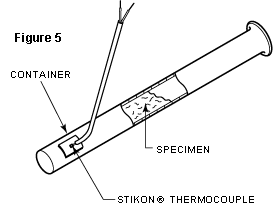
1. Biological Sensor (Figure 5)
Biological samples are often frozen for future use. A few examples are:
| 1. |
The freezing of cancer cells for future research.
|
| 2. |
The freezing of skin tissue removed from cadavers for grafts on burn patients.
|
| 3. |
The freezing of animal sperm for future insemination and special breeding.
|
Living tissue is primarily water and as it freezes the water will expand, causing friction in the cells and possibly destroying the specimen.
For this reason it is extremely important to carefully control the freezing rate.
An RdF Stikon® thermocouple can be used for this application.
A Type “T” thermocouple is chosen because it has published limits of error below 0°C.
It is attached to the specimen container and is immersed into a cooling solution.
Due to the low thermal mass of the thermocouple bead it can accurately follow the cooling process of the specimen.
After the temperature of the sample is stabilized it can be moved to a storage area and the thermocouple can be removed for use on another container.
In this case a pressure sensitive silicone adhesive can be used easily.
|




